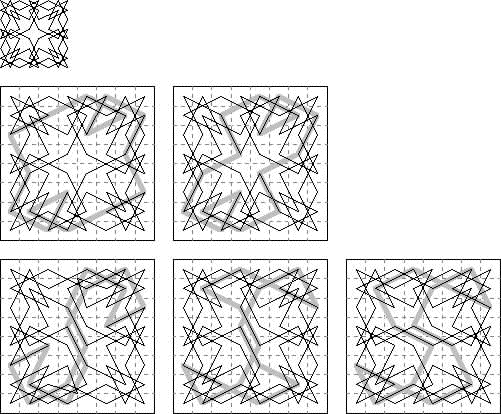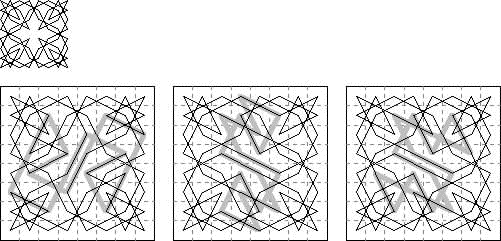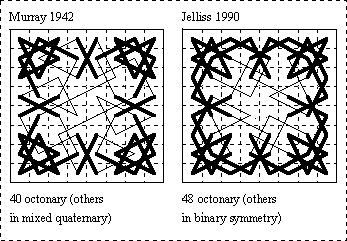
The term octonarian is used here to describe tours that either have a marked degree of octonary symmetry or else are constructed by simple-linking of pseudotours that have octonary symmetry.
Tours with complete octonary symmetry are not possible on even-sided squares, though pseudotours (i.e. superpositions of separate circuits) are, provided the number of cells in a side is a multiple of 4. On the 4×4 board of course there is just the one octonary pseudotour: the squares and diamonds pattern. On odd-sided squares pseudotours of the whole area omitting the centre cell are possible. For example on the 5×5 board we can combine an 8-move circuit 1.5 with the 16-move tour 3.4.2 to give a pseudotour which is useful in classifying 5×5 open tours. Octonary patterns can be formed on squares of side 4n + 2 provided four cells on the diagonals are are omitted. There are seven pseudotours of this type on the 6×6 board. We also show some 7×7 examples.

There are 33 octonary pseudotours on the 8×8 board. Two of these are of particular historical interest, namely those containing the 4×4 array of squares and diamonds, either in the centre, surrounded by a border, or in each quarter of the board. The first of these was studied by Collini (1773) and the second by von Schinnern (1825) and others. The remaining 31 cases do not seem to have been studied until I investigated them in Chessics (1985). The notation 2@28 + 2@4, for example, means a pseudotour with 2 circuits of 28 moves and 2 circuits of 4 moves.

The 33 consist of: (a) 14 having all the circuits co-centric with the board, including the Collini pseudotour; (b) 9 where some are co-centric and others not; (c) 10 where the circuits are distributed symmetrically round the centre, including the squares and diamonds case.
The process that I call ‘simple linking’ of pseudotours proceeds by deleting one move in each circuit and connecting up the loose ends to form a proper tour. The deleted and inserted moves then alternate and form a ‘linkage polygon’.
In the cases with co-centric circuits this process will only form asymmetric tours. Here are diagrams of the eight asymmetric tours formed by simple linking from the two pseudotours containing 28-move circuits. The thick grey lines show the 8-move linkage polygon formed by the inserted and deleted moves. The first solution in each case uses a linkage polygon without self-intersection.
A.

B.

Most of the other asymmetric cases have not yet been investigated.
Seven of the tours in the last class (c) will produce symmetric tours by simple linking. These cases include the 16-circuit squares and diamonds pattern which of course produces a large number of tours (as yet undetermined). The other six produce only 31 symmetric tours in all, as shown in the following diagrams. The three pseudotours formed of 8 circuits of 8 (which we write 8@8) produce 4, 5 and 12 tours (total 21). Three of the tours of type 4@12 + 4@4 produce 3, 3 and 4 tours (total 10). Since there are 8 circuits to be linked in these cases, there are 8 deletions and 8 insertions making a 16-move linkage polygon, shown by the thick grey lines.
A. 8 circuits of 8 ('stars' and 'rockets').

B. 8 circuits of 8.

C. 8 circuits of 8: This case gives 12 tours from the one octonary pattern.

D. 4@12 + 4@4.

E. 4@12 + 4@4.

F. 4@12 + 4@4.

While completely octonary tours on the 8×8 are impossible, it may be of interest to find the maximum amount of octonary symmetry that can be achieved within a tour. H. J. R. Murray (1942) gave the following example showing 40 moves in octonary symmetry (the remaining 24 being 12 in direct and 12 in oblique quaternary symmetry), thus making a tour of ‘mixed quaternary symmetry’ (which is a special type of binary symmetry invented by Bergholt 1918). My example increases the number of moves in octonary symmetry to 48 but the remaining moves are only in ordinary binary symmetry, not mixed quaternary symmetry.
